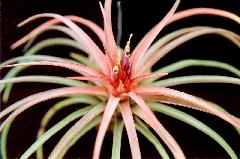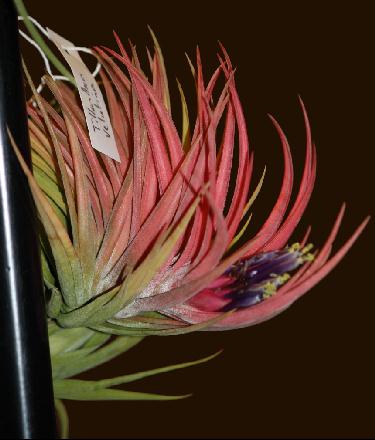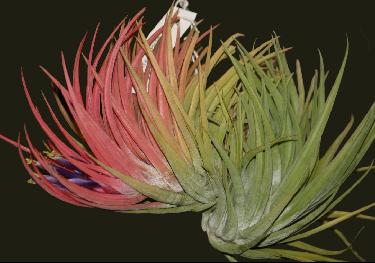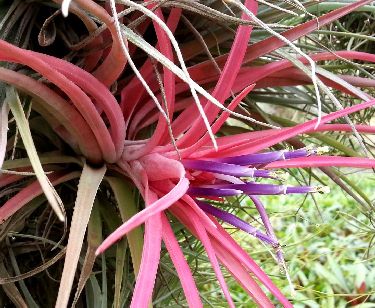








Plant stemless, growing in clumps, flowering to 15 cm high, to 25 cm wide.
Leaves rosulate, numerous, spreading and decurved, dark green, with dense trichome covering.
Leaf sheaths to 3 cm long, to 2 cm wide, indistinct, castaneous, abaxially densely grey, adaxially finely brown lepidote, the margins fringed with asymmetric, small trichomes.
Leaf blade to 1.5 cm wide at base, narrowly triangular, attenuate, to 18 cm long, involute, abaxially keeled, dark green, densely fine-pruinose lepidote, more so abaxially.
Scape short, 5-10 mm long, erect, stout, 1 cm in diameter;
Scape bracts foliaceous, very densely imbricate, sheaths to 2 cm long, ovate, distinct, imbricate and concealing the scape, the lower with blades to 10 cm long and reflexed, the upper ones to 7 cm long and spreading, densely fine-pruinose lepidote, at anthesis blushing carmine.
Inflorescence ovate-capitate, to 3 cm long, to 2 cm in diameter, compound, with up to 9 densely polystichously arranged spikes one- to two-flowered and apically with up to 4 single, densely arranged, erect flowers (often with an additional depauperate one).
Primary bract sheaths equalling the spike, enfolding its flat side and concealing it, the blades of the lower ones to 7 cm long narrowly triangular attenuate, reflexed, the apical ones very short and reduced.
Spikes sessile, to 2.5 cm long, 1.2 cm wide, complanate, two-flowered (sometimes with an additional small, sterile one), or reduced to 1 flower.
Flowers sessile. In the apical flowers, primary and floral bracts are reduced to one bract with intermediate characters, membranaceous, slightly lepidote and longer than the sepals.
Floral bracts shorter than the sepals, 1.2-2 cm long, to 8 mm wide, elliptic, subacute, membranaceous, with hyaline margins, rose or carmine, white at base, nerved, glabrous, from nearly ecarinate to carinate.
Sepals 1.8-2.3 cm long, to 5mm wide, lanceolate, acute, membranaceous, nerved, yellow with rose apices, the abaxial one slightly, the adaxial ones strongly carinate and 8-14 mm connate, nearly glabrous, (only sparsely enlarged, punctuate lepidote).
Petals to 4.7 cm long, blade 9 mm wide, acute, spatulate, indented along the sides, towards base 3 mm wide, forming an erect tube, the tips slightly curled back, violet, the apex lighter, amethyst, basal third white.
Stamens to 15 mm exserted.
Filaments to 6 cm long, in two sets of unequal length, near apex 1 mm wide, the apex rounded, violet (concolorous with the petals), towards base thin and white, somewhat twisted.
Anthers erect, 2.5 mm long, 0.75-1 mm wide, elliptic, 1/3 from base versatilely fixed, castaneous, pollen light yellow.
Style to 5.5 cm long, white, apically with violet spots, stigma 15 mm long, 15 mm wide, lobes erect, light green, slightly papillose
Type 1 Brown & Gilmartin (1984)
.
Ovary 6 mm high, 25 mm wide at base, conical, triangular in cross section, white.
Holotype. Mexico. State of Chiapas, on road from Motozintla to Tapachula, 1800 m s.m., leg. K. & R. Ehlers 891303 (holotype, WU; isotypes, WU). Growing on pine trees with Tillandsia fuchsii Till, T. butzii Mez.
Habitat. Guatemala and Mexico near the common border. In Guatemala, the plant grows in humid forest areas, mostly on volcanic mountains.
Etymology: The name is taken from the Latin adjective, velutina, meaning velvety.
Additional material. Mexico. Chiapas, Motozintla, leg. K. & R. Ehlers EM 880707, 7.3.88. Guatemala. Depto. Guatemala, Antigua, San Lucas, Vulcan Bacaya 1200-2000 m, leg. Uwe Feldhoff & Jiirgen Mowinski, 1989.
Tillandsia velutina differs from T. brachycaulos Schlechtendal as follows:
Plant a more spreading rosette,
Leaves darker green, more densely pruinose lepidote on both sides, the indistinct sheaths castaneous.
Scape bracts densely pruinose. At anthesis, the interior leaves and primary bracts blush carmine in contrast to the cherry color of T. brachycaulos.
Scape is shorter,
Spikes are without sterile bracts, at the apex of the inflorescence several single flowers appear without primary bracts (in T. brachycaulos the apical spikes mostly are reduced to a single flower subtended by a primary bract).
The first flowers appear at apex and the last flowers bloom from the basal spikes (the reverse in T. brachycaulos).
Floral bracts and sepals are longer,
Petals are somewhat shorter.
Tillandsia velutina grows in damp forests, 1200-2200 m s.m. while T. brachycaulos normally grows from sea level to 1200 m (up to 1700 m) in dry areas.
Material of Tillandsia brachycaulos Schlechtendal examined:
Mexico. Temascaltepec, 1600 m s.m. K. & R. Ehlers EM 851418; Morelos Tepoztlan 1700 m s.m. EM90030; Michoacan, K. & B. Woditsch s.n., March 1987; Morelia, Acostitlan EM 902503; Oaxaca: Pochutla EM 881303; Guelatao 1700 m L. Hromadnik HR 4047; Chiapas: La Trinitaria EM 891206; Frontera Contalapa EM 891207.
Guatemala. Zacapa: Rancho and Rio Rondo leg. U Feldhoffs.n., 1989.
Costa Rica. Puerto Arenas-Puerto Blanca leg. U Feldhoffs.n., 1989.
Nicaragua. Volcan Mombacho, leg. Petr Stary CSFR s.n., 1989.
Tillandsia velutina also differs from T. abdita L.B. Smith by its glabrous floral bracts and subglabrous sepals, which are connate for up to 14 mm for the adaxial pair.
Notes
This plant, for which I propose the name Tillandsia velutina, has been available for many years in nurseries and sold under various names such as T. abdita or T. brachycaulos var. multiflora. (T. brachycaulos var. multiflora is considered by many specialists to represent a natural hybrid of T. brachycaulos and T. caput-medusae.-H.E.L.)
There is a very nice color photo of it in Paul Isley's book TILLANDSIA (pages 28-29) and his description mentions "a velvety look and feel."
When we collected the plant in 1988 on our first trip to Chiapas, I studied the material and found that it differed in so many characters from Tillandsia brachycaulos that it should be considered a new species.
Tillandsia velutina R. Ehlers differs from T. brachycaulos Schlechtendal, by the stronger radiating rosette, the darker green leaves with indistinct, brown sheaths, with more dense and velvety scales on both sides. The stem bracts are also densely lepidote. During the peak blooming period, the floral bracts and primary bracts take on an intensive carmine red colour - as opposed to the cherry red colour of T. brachycaulos. The stem is shorter, nearly non-existent. There are no sterile bracts on the base of the spike, there are several individual flowers at the tip of the inflorescence which do not have a primary bract. (With T. brachycaulos, the top spikes are also usually reduced to a single flower, but this is surrounded by a primary bract). The first flowers appear at the tip of the inflorescence and the lowest spikes flower last. This is exactly the opposite with T. brachycaulos. The flower bracts are longer, the sepals are longer, the petals a little shorter with an elliptic blade.
The plant grows in moist forest areas, in higher locations up to 2200m while T. brachycaulos generally grows in lower areas and drier, hotter zones.
It differs from T. abdita L.B.Smith by its bare flower bracts, the nearly bare sepals whose rear ones are fused (connate) by up to 14 mm.
(Reprinted with acknowledgement to Die Bromelie, Journal of the Deutsche Bromeliengesellschaft, Issue 1/1995).